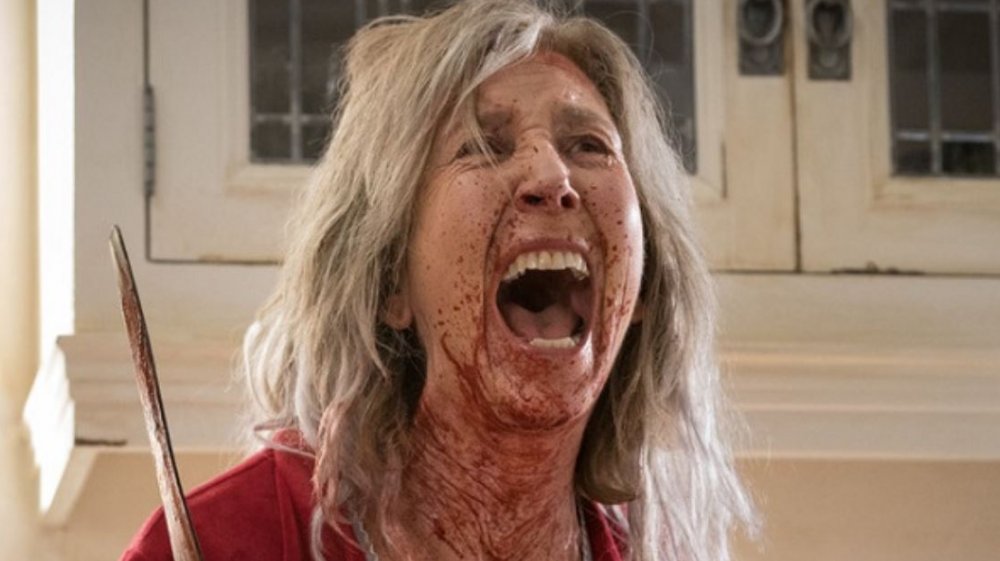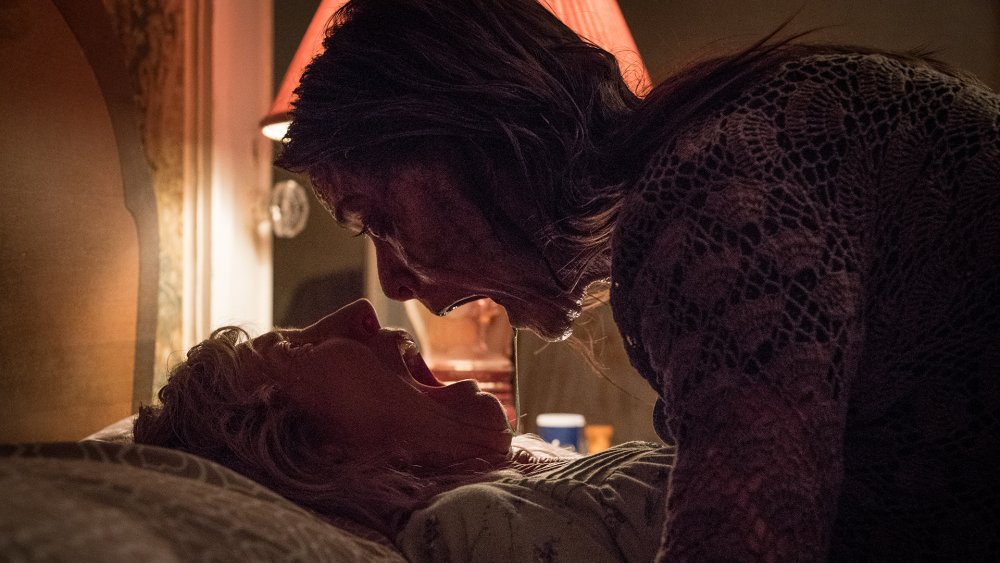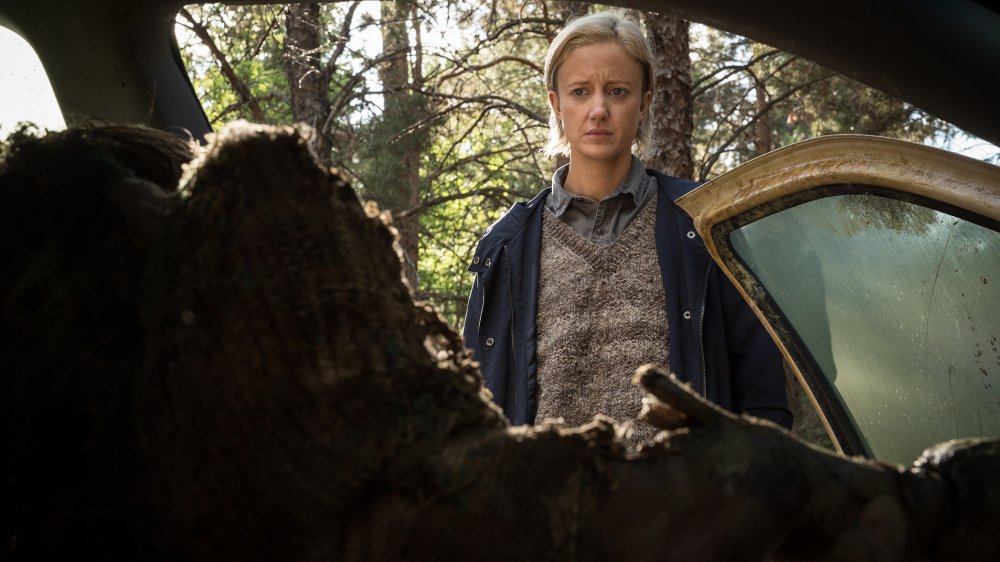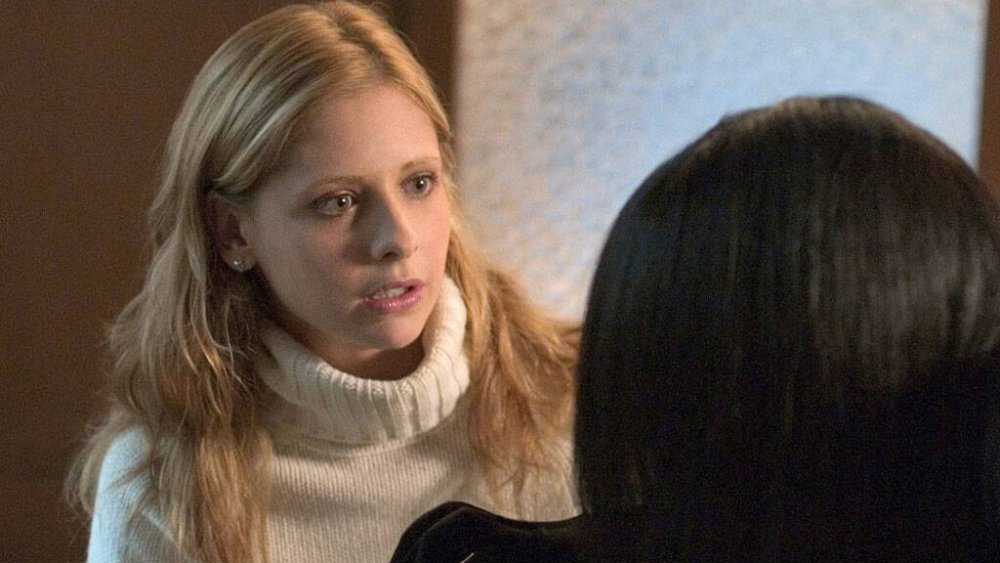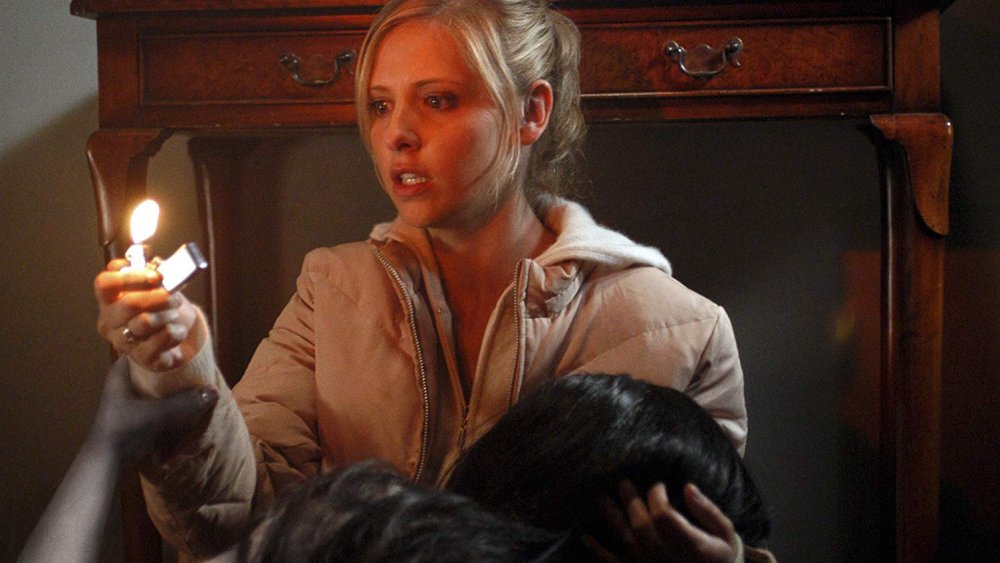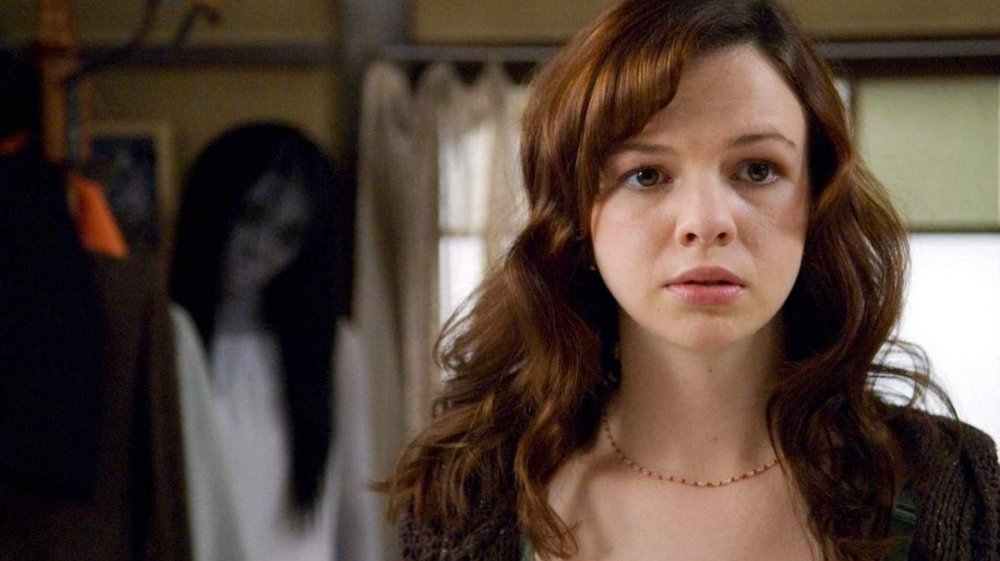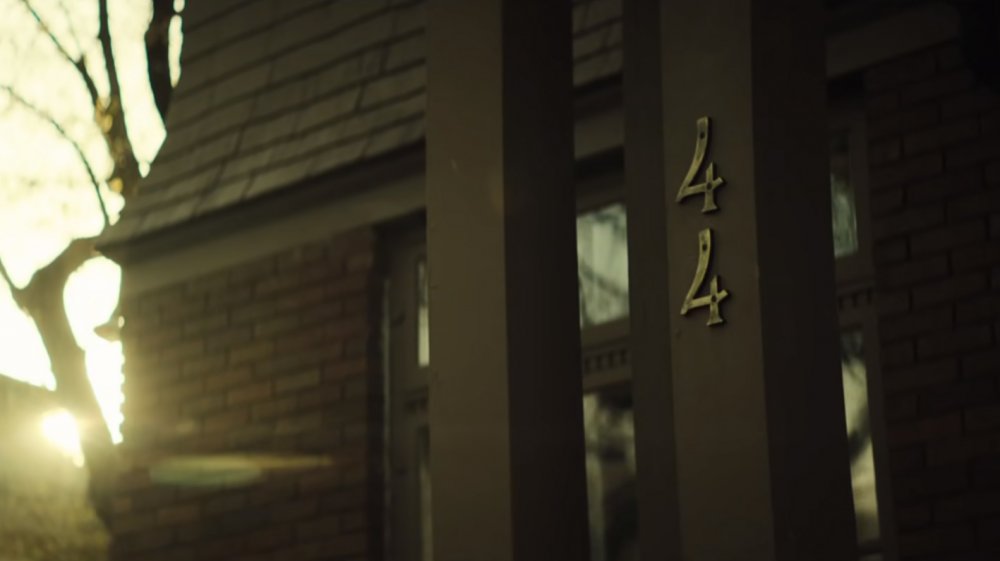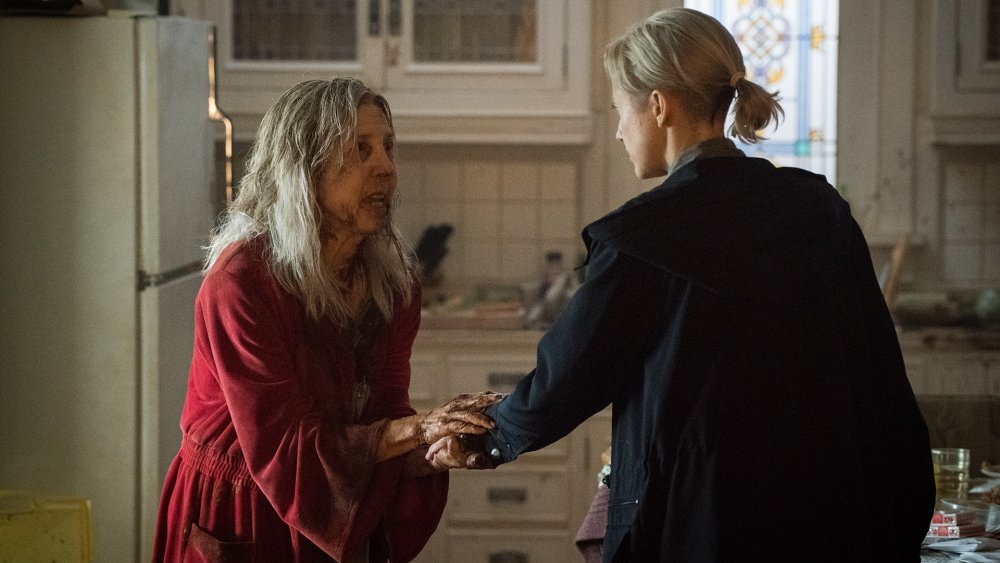The Ending Of The Grudge Reboot Explained
Every Grudge movie starts with a warning: "When someone dies in the grip of a powerful rage, a curse is born." That curse lives where the death takes place. Enter, and you'll never be the same.
The new Grudge reboot from director Nicolas Pesce is no different. But it's not just the basic premise that The Grudge shares with its predecessors. It also has a haunted house, a creepy kid, mysterious murders, and a non-linear storyline that builds to a big, spooky reveal.
It's a lot to keep track of, and the pieces don't fully come together until the climax, when Detective Muldoon heads to the house at 44 Reyburn Drive to try and end the curse once and for all. You probably didn't get too lost along the way — The Grudge is many things, but subtle ain't one of 'em — but just in case, here's everything you need to know (with plenty of spoilers) to make sense of The Grudge's shocking ending.
A story of three families
The Grudge tells its story out of order, saving the big reveals for when they will deliver the biggest emotional punch. Telling the story chronologically isn't as interesting, but it is necessary to understand the ending.
In 2004, Fiona Landers returns home from Japan, where she worked as a caretaker in a cursed house. Unfortunately, while Fiona is happy to be reunited with her husband Sam and her daughter Melinda, the joy doesn't last. The curse has followed Fiona home to 44 Reyburn Drive, where, driven mad by the apparitions she sees, she drowns Melinda and stabs Sam, then commits suicide.
Shortly afterwards, married real-estate agents Peter and Nina Spencer, unaware that the Landers have been murdered, try to sell the Reyburn house. Peter goes inside the house, but Nina, who's pregnant, doesn't. The curse attaches itself to Peter, who stabs Nina in their kitchen before drowning himself in their tub.
In 2005, Faith and William Matheson move into the house so that Faith, who has cancer, can be closer to her doctors. Both Faith and William see ghosts, but while William isn't too worried, Faith loses her mind. By the time Lorna Moody, an assisted suicide attendant, comes by to help Faith die with dignity, Faith is completely gone. Faith murders William and cuts off her own fingers. Lorna flees, but sees a vision of Sam Landers while driving and crashes her car. Her body isn't found for months.
Moral of the story? Stay out of 44 Reyburn Drive
This is where Detective Muldoon enters the picture. In 2006, Muldoon moves to town just a few months after losing her husband, forcing her to raise her son Burke alone. Her new partner, Detective Goodman, has a few tragedies in his past, too. His original partner, Wilson, became obsessed with the house at 44 Reyburn Drive after investigating the Landers killings, and eventually shot himself (he survived, and is now institutionalized). In addition, Goodman's mother recently passed away, and Goodman is so distraught that he hasn't bothered to remove her bed and oxygen tanks from his home.
Most importantly, however, Goodman isn't haunted by the curse. See, he never stepped inside the Reyburn house — it gave him a weird feeling, so he stayed away — and so he's free of its supernatural tormentors. The original Grudge hinted at the idea (and its sequels made it explicit), but the reboot makes it clear: the ju-on, or "grudge," will infect anyone who steps into the location where the curse lives. Stay outside, and you're fine.
Muldoon doesn't know this, though, so she enters the house while investigating Lorna Moody's death. Almost immediately, the Landers family begins haunting her. Afraid that the visions will make her hurt Burke, Muldoon decides to burn the Reyburn house to the ground, hopefully ending the curse. The house is (presumably) destroyed, but as the final scene shows, it doesn't do much. The Landers' spirits are still around.
The original grudge was, well, the original Grudge
There's one big question that The Grudge doesn't explicitly answer, and it's a big one: What horrific act of violence created the curse? The 2020 film begins with the curse already active. Fiona has already been infected in the opening scene. When she returns home, her family's death is a foregone conclusion.
To find the explanation, you actually need to go back to the 2004 version of The Grudge. Yup, that's right: The Japanese house where Fiona works in is the same one featured in the Sarah Michelle Gellar flick that kicked off the Grudge franchise (the American version, anyway). In the 2004 movie, we learn that the curse was born when Takeo Saeki learned that his wife, Kayako, was in love with her college professor. In a fit of jealousy, Takeo murdered Kayako and their son, Toshio, creating the curse (Toshio later returned and hanged his dad).
The Grudge reboot doesn't spell this out, but the clues are there. Fiona says she was working in Japan for the Wilsons, which is the same family that Gellar's character gets mixed up with. Detective Wilson says that he's talked to a detective named Nakagawa, who investigated a murder at the house where Fiona was working. That's the Japanese detective who appeared in the original Grudge. The house in the opening scene also looks a lot like the one in the 2004 movie, and the film's end credits confirm that the ghost Fiona sees in the garbage bag is indeed Kayako, the antagonist of the first three Grudge movies.
An ending so nice they used it twice
The two Grudge movies connect in other ways, too. Not only did the original Grudge set up the events of the new one, but their endings parallel one another perfectly.
In the 2004 Grudge, Sarah Michelle Gellar's care worker, Karen Davis, tries to end the curse by burning the Saeki house to the ground. She douses the house in gasoline and lights the fire, but it doesn't work. When she wakes up in the hospital, Karen learns that firefighters saved the house, and Kayako's ghost returns to torment her as she visits the body of her deceased boyfriend.
Muldoon also tries to solve her problem by burning down the Reyburn house. Her plan is more intentional — Karen simply finds the gasoline, but Muldoon brings it with her — and she seems to be more successful (the last time we see the Reyburn house, it's a raging inferno), but her efforts end up similarly futile. The morning after the fire, Muldoon gets Burke ready for school, only to find Melinda Landers' spirit masquerading as the boy — and the rest of the Landers family lurking nearby, ready to cause trouble.
A roadmap for future sequels
Given that the 2004 Grudge and the 2020 Grudge hew to the same formula, it's possible that the reboot's sequels will too. If so, here's what you can expect.
Like the 2020 version of The Grudge, The Grudge 2 takes place between 2004 and 2006. In the earlier timeline, Karen's sister, Aubrey, travels to Japan to bring Karen home, and ends up infected by the curse — and dying for her efforts. In the 2006 story, three girls break into the Saeki house on a dare. Two die, but another, haunted by Aubrey's spirit and Kayako, returns to the United States, bringing the curse to Chicago.
In The Grudge 3, the sole surviving victim from the previous movie dies, attracting the attention of Kayako's sister Naoko. Naoko moves to America and tries to exorcise Takeo Saeki's spirit, hoping to end the curse once and for all. The results are mixed. Naoko is killed during the process, and while the exorcism is successful, Naoko's murder sparks a whole new grudge, starting the process all over again.
Has a new spawning ground been born?
On the other hand, the Grudge reboot introduces enough new ideas to the mythology that a potential sequel could go in a different direction. The revamp makes it clear that the curse can spread not just from person to person but from location to location. The Saeki house might've been where it started, but the Reyburn house ends up just as dangerous.
If Muldoon's house is now another home base for the curse, it wouldn't be too surprising. We don't know if Muldoon died at the end of the movie or not, but the final shot of the movie ominously lingers on her house. The house is filmed similarly to the Reyburn house, too, with its street address — number 14 — featuring prominently in the frame.
It could be that the Landers family relocated to Muldoon's property when the Reyburn house burned down, or maybe the town now has two ghostly hotspots. Either way, if Burke asks your kid to stop by for a sleepover, you should probably say no.
Or is it a happy ending?
Of course, The Grudge raises the possibility that there's a silver lining to this curse. Maybe, just maybe, the curse's victims will all live together in the afterlife and enjoy each others' company while they torture unsuspecting houseguests.
That's the possibility — well, with a little less murder — floated by William Matheson. While he can see the Landers' ghosts, he's not scared of them. They make him hopeful. The ghosts prove that there's life after death, William says, at least for people who succumb to the curse. With Faith on death's door, William clings to the belief that his wife's spirit will live on in the house once she passes, and that when he dies his spirt will join her..
Sure, it's a bit of a stretch. The ghosts in The Grudge are clearly evil, and brutally slaughtering innocent people is a weird definition of "domestic bliss." Still, William has a point. All of the curse's victims die in horrific, violent ways, which seems to be the key to sticking around postmortem — and anyway, what's wrong with a life of murder and mayhem, as long as you're doing it alongside the people you love?
